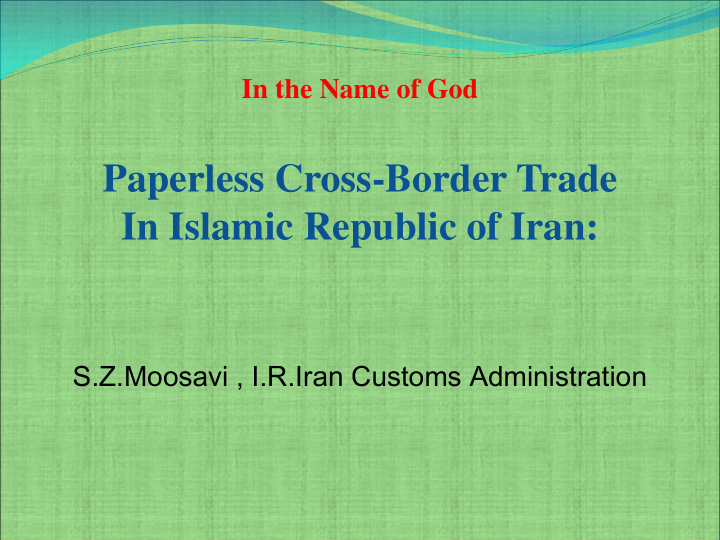



In the Name of God Paperless Cross-Border Trade In Islamic Republic of Iran: S.Z.Moosavi , I.R.Iran Customs Administration
Many national and international laws and instruments recognize customs administrations crucial role in trade facilitation , harmonization of border controls and employment of e-tools as well , such as : Articles 1 and 2 of new Iranian Customs Law wherein customs is responsible for implementation of import , export and transit of goods and trade facilitation as well. Article 12 of new Iranian Customs Law wherein border control agencies are required to do the controls under customs supervision .
WCO (World Customs Organization) Framework of Standards to Facilitate and Secure Global Trade , in particular its first core element which emphasizes identification of high risk consignments by advance electronic information . WTO Trade Facilitation Agreement whose most provisions concern fast and more efficient customs procedures , particularly item ( para) 1 of Article 7 advance electronic data is indicated(emphasized).
The Customs Convention on the Harmonization of Border Controls of Goods which emphasizes the customs responsibility in harmonization of controls at borders . Some new rules recently approved require customs in using e-systems for customs formalities , such as : a) Government Cabinet decision no. N 45059T/128188 especially Article 5, b) Government Cabinet Decision no. 45059/116676, especially Article 4 ,
Measures taken by I.R.Iran Customs Administration in establishing paperless cross-border trade: Introduction of Integrated Comprehensive Customs System (ICCS) 1. Rules that required ICCS introduction: a) Iran Five Year Development Plan , b) Government policies on the introduction of e-government for promotion of external trade , grant of facilities to traders and reduction of goods release time ,
c)Iran Visionary Plan , d)WCO recommendations , e)Article 9 of Customs Law that requires Customs for using ICT, f) Government Cabinet Decision no. N 45059T/128188 in which Customs is obliged to establish e-declaration and e-document systems,
ICCS capabilities : a) It can cover all customs processes and clearance operation from the entry of goods to customs up to end of customs formalities including : At import level it is able to cover e-declaration , weighing , warehousing, exit door , At transit level it can cover all the processes including seals controls , goods authentication and transmission of data both to departure ( entry ) and destination ( exit ) office to ensure exit or clearance of goods E-declaration by which a customs client can declare its goods electronically while in his office without having to be present at customs office,
Implementation of Coordinated Border Management(CBM) a) Legal frameworks requiring CBM introduction: 1. Harmonization Convention , to which Iran acceded in 2006, in particular Article 4 of the convention and also Article 1 of Annex 1 that recognizes customs responsibility for harmonizing other agencies for border controls , 2.Revised Kyoto Convention (RKC) especially the standards 3-4 and 3-5, 3.Nairobi Convention (International Convention on Mutual Administrative Assistance for the Prevention , Investigation and Repression of Customs Offences )
4. New customs law ( Article 12) : in order to facilitate and speed up customs formalities at entry and exit points representatives of agencies responsible for border controls should act under customs inspection , 5. New customs law Rules of Procedures , especially Article 8 Introduction of Cross-border Single Window Instruments that recognizes customs lead and managing a) of cross-border single window Items 3 and 4 of government cabinet decision no. 1) 55544T42210 2) The strategic Plan for Prevention and Fight with Smuggling of Goods and Foreign Currencies,
3)Article 7 of Iran 5 th Economic, Cultural and Social Development Plan Law, 4) WCO instruments on introducing single window by Member States customs administration such as WCO Data Model , Single Window Data Harmonization , b) Benefits of Single Window introduction: 1) Higher transparency in customs and trade activities , 2) Import and export release time reduction , 3) Increase of customs revenues , 4) Reduction of corruption ,offences and goods smuggling
5) Facilitation of legal trade 6) Reduction of papers in trade through use of e-documents . Major challenges faced : 1) Lack of accurate identification of single window concept, functions and specifications , 2) Interference of bodies irrelevant with cross border trade , 3) Diverse systems in cross border trade processes , 4) Lack of full understanding in other agencies of customs role , share and place at trade facilitation .
Pilot Project: eTIR Pilot Project with Turkey and participation of IRU, UNECE, Iranian and Turkish Chambers of Commerce which started in 2014, its first phase completed successfully in 2015 and the second phase is under way now.
Thanks For Your Patience and Attention S.Z.Moosavi , I.R.Iran Customs Administration
Recommend
More recommend